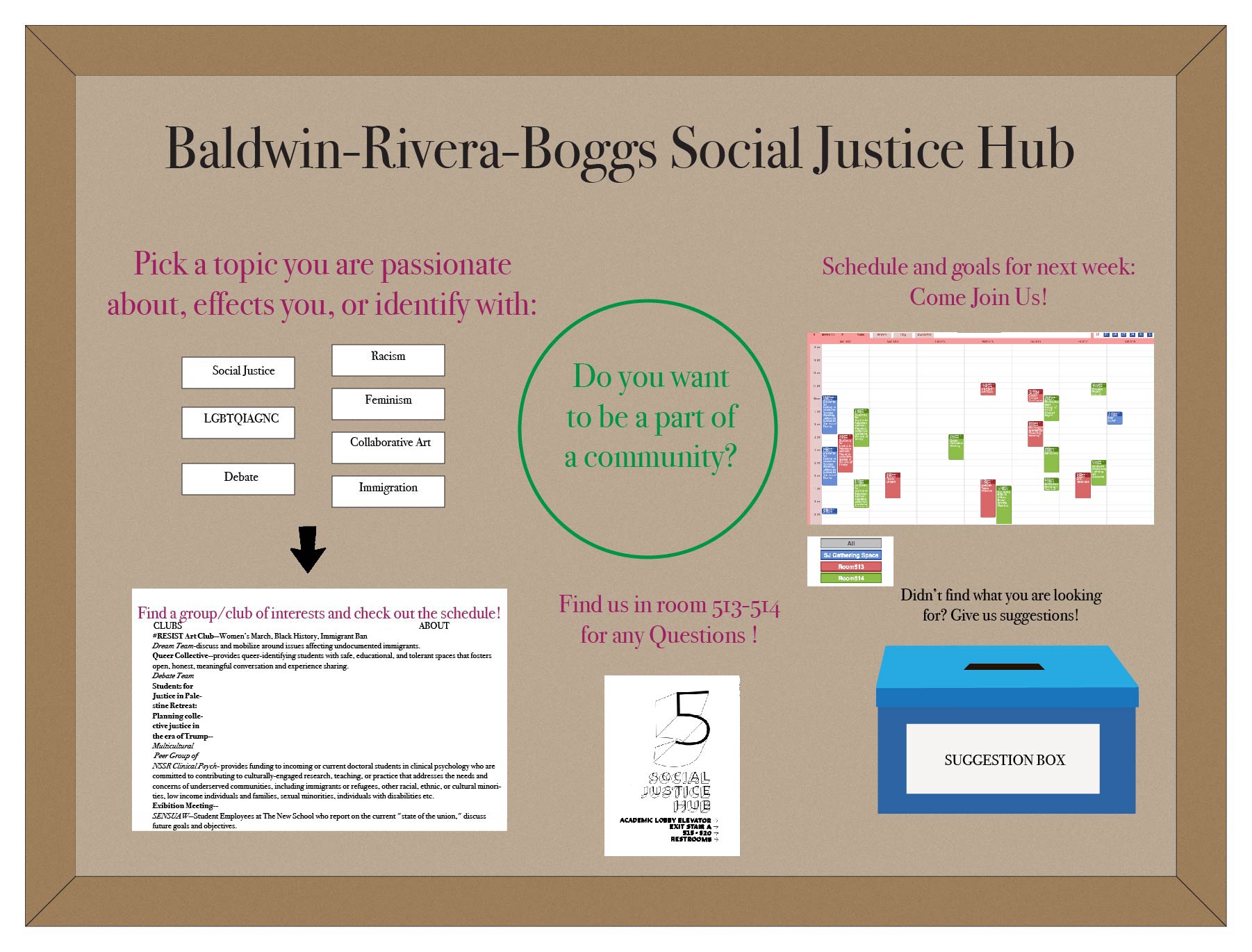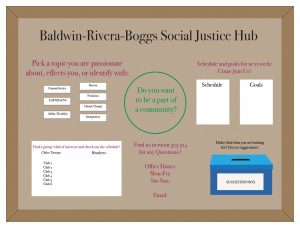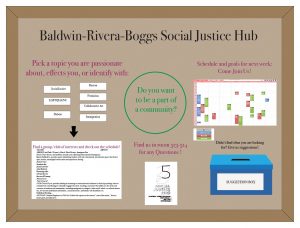FIRST POST
This design would benefit New School students and individuals involved with the Social Justice Committee. Students that want to get involved in the Hub can find the place for them and be a part of that community. This bulletin board will promote the Social Justice Hub and the communities within it to create awareness and involvement! This method is also extremely helpful to group members that missed the last meeting or are unsure of when/where the next one is being held. The Bulletin Board would be designated and organized specifically for the Social Justice Hub so that there are NOT a million loose posters and flyers around that people would normally ignore. I believe that the large question in the middle will grab people’s attention. The suggestion box would allow anyone to provide feedback to the Social Justice Hub to improve the system and the way the Hub is ran. The Bulletin would be updated as necessary- posting new schedules, goals, and clubs. It could be placed in the Social Justice Hub on the 5th floor where most people would see it. I think there are a lot of students that would enjoy joining a group at the Hub but are not aware of its purpose. Picking a category and finding a club that matches will give the student the opportunity to realize they can meet people to share and discuss ideas about that topic. I think posting the group members and faculty’s names in addition to email would allow students to ask questions when no one is around the Hub, the board also provides where they could find those important people during office hours.
Design Justice Checklist:
Ignoring:
- Storytelling
- Connecting to the Earth
- Fluid understanding
- Participation- in the prototype itself
- Sustained Engagement
Adhering to:
- With Not For
- Transformation
- Process
- Equal advantage and opportunity
- Becoming part of the community
- Seeking existing resources and strategies at the margins
- The possibility for all people to design their own solutions and lives
Ideally, I would want this bulletin board to be quite large, so that people notice it. But, I don’t know if I will be able to get the provided space in the Social Justice Hub. Also, it would be extremely helpful if I could designate one of the preexisting bulletins in the wall for this temporary project. There is a lot of research and connecting to be done, I’m questioning whether I’ll be able to access and find all of this information in order to make this system successful. The topics I chose were based on what I think might already be a club, they serve as examples and I will need more research to finalize them. I don’t think I need all members names, but I do believe the leaders and faculty names and emails would be extremely beneficial. Depending on the difficulty, I think my process to create the Bulletin Board will be a reflection of how hard it is for New School students to gain information about the Social Justice Hub. The schedule and information should be easy to find, especially if serves the purpose of an organization for clubs! When a system is organized, it is bound to be more successful. The bulletin board is not recreating the system, but is like a crutch supporting and improving the existing design.
I would create and design the bulletin board to its fullest potential and hang or post it in the busiest area of the Social Justice Hub, maybe the 5th floor lounge area if possible. Scraps of paper and pens would be placed next to the suggestion box. I originally wanted my prototype to be an interactive bulletin but I think there are possibilities of people not taking it seriously. Even with the suggestion box, this is still possible. Whereas this informative bulletin is more fact based but also adheres to students opinions and suggestions. My main concern is even though this will benefit the Social Justice Hub in terms of awareness, what will it eventually bring to the table? More people? I’m hoping yes, but also considering what goes on inside the Hub to see if there are other systems that could be improved or altered that specifically engage the members of the Social Justice Hub even more.
SECOND POST
- How effectively does the purpose/ function of this design proposal connect with the BRB Social Justice Hub’s intended community? Is it empowering and productive? How so? What evidence do you have to demonstrate how well this design aligns with the mission of the space?
- Challenge yourself to center the Hub “community” instead of simply relying on your own instincts.
- Some questions to consider:
How does/ has your identity impacted your engagement in this assignment? Consider the role your race/ gender/ class/ sexual orientation have played in your research, your design proposal and your engagement with the BRB SJ Hub community.
To improve my design proposal, I would have liked to make this bulletin board more interactive. My original inspiration for this assignment was the interactive project at the Cooper-Hewitt Smithsonian Design Museum. I wanted to incorporate the concept of individuals finding a club of their interest in addition to providing the information of the Hub instead of posting flyers in hopes that people would look at it. I would say that my project is unfinished for many different reasons but has the potential to be empowering and productive. If I made more alterations or left my project up for a longer period, I might’ve gotten some interaction.
In the beginning of the process, I wanted to get approval from some or all the clubs to be able to share their schedule and what the group was about rather than sharing information that was not mine to be shared. Also, I was unable to find information on some of the clubs, meetings, and gatherings or the information was vague. I did not want to be inaccurate with sharing false information to my audience and potentially leaving them disappointed when/ if they participated in one of the gatherings. But, I think the Hub community would like this idea because it is a way that shares their goals and schedule in an organized fashion and shows openness to The New School community outside the Hub that would like to participate in such events and groups. The bulletin board suggests access to the Hub all students as well as allowing anyone to give suggestions to improve the Hub in any way.
In terms of my own identity, I tried to change my perspective. But, I am not a part of the Social Justice Hub so it was difficult to decide what they need considering I was not collaborating with them; I was on the outside. So, I used my perspective to my advantage; I knew nothing about the Hub in the beginning of this assignment and had to use the resources I could find. I thought, “If I were looking for a club that discusses the LGBTQ+ community for example, where or who would I turn to?” The lack of sharing information was present, and the simplest form of finding a solution to this problem was a bulletin board located in the Hub itself. Although this is not adhering to members of the Hub directly, it is improving the awareness of the Hub for people like me who did not know what it was. It is inspiring others to join a group based on something that interests, affects, challenges, or identifies with in their everyday life. If I were to propose this idea to the Social Justice Hub, I would say that the bulletin board would be permanent and that everything would need to be regularly updated so that everyone would know where to find it and what to look for. I wanted my idea to attract people that could engage in a community within The Social Justice Hub that were unaware of the groups they could be a part of.
- How representative of the BRB SJ Hub community is the target audience you’ve selected?
- Who is being targeted? Why? How?
I am targeting New School students that are NOT involved in the Hub. I think the questions, especially the one in the middle would grab people’s attention. The bulletin board is specifically asking the viewer what they want as well as providing information. It also allows them to suggest opinions and ideas to the Hub, which gives members insight of what it is like outside of the Hub community to improve awareness to grow a larger community and better the system. As someone who didn’t know a lot about the Social Justice Hub, I think the bulletin board is a good representation of New School Students that don’t know what it is, providing all the current information. Also, it is beneficial to members of the Hub to check out the bulletin for current events and goals as well. I would consider adding the history of the Social Justice Hub to give my audience more background and to show the purpose of the utilized space.
- How effective are the techniques you’ve chosen to engage your target population?
- Was the designer effective in finding their identified target audience? If not, how else might they go about this?
- Were the methods used effective in allowing their target audience to engage meaningfully with this design? If not, what could have been done more effectively?
If this project were to be extended, I would create a large bulletin board which would grab attention even more. Again, I would make it more collaborative such as providing paper to pick a category and pick a club they like, or suggest on the bulletin board to take a picture of the schedule and clubs. Also, the bulletin would provide Facebook groups, Instagram accounts, emails, and hashtags made by the Hub members. Reflecting on the tested the prototype, I think if my project suggested interaction more, I might’ve been more successful. I put up my prototype on the big bulletin board on the 5th floor where posters are normally hung. I think the location of my prototype defeats the purpose of it. If I put it on a blank wall on its own for a longer period, I might’ve gotten better results.
- Does the documentation of the engagement process effectively communicate the value of this project?
- Did the documentation process distract participants from engaging genuinely? If so, how could this be done differently?
- Are participants able to fully experience this design proposal? If not, what’s missing, and how might they experience that component?
My audience did not get the full experience from the prototype because it was not an actual bulletin board. To experience the full effect, I would create a large bulletin with colorful words and big text to grab attention. The documentation process did not distract participants, I was sitting on the 5th floor “working” on homework as other students were, waiting for students to walk by and interact, but unfortunately, no one did.
- Which of the Design Justice framework points have you actively adhered to, and which have you not fulfilled? Why is that? How can you fulfill more of these points for this assignment? For future work?
I am adhering to the transformation and the possibility for all people to design their own solutions and lives within the design Justice Framework. The bulletin board fulfills transformation because it is welcoming students to gain knowledge on the Social Justice Hub and join. This will get students more involved because they know what’s happening within the Hub and will increase the Hub’s group size. It is working on the possibility for all people to design their own solutions and lives because people are choosing a group to join and if they are not satisfied with the options, they can contact a member of the Hub to see if the type of club they are looking for exists, or leave a suggestion. I believe that I am also reimagining the original design of a bulletin itself by making it interactive instead of being a place to put information.
I have ignored the with/not for principle, sustaining engagement, and reimagining the design. I was unable to collaborate with members of the Hub effectively. When Gale came in to critique our work, it was very helpful and taught me a lot about presenting information efficiently. I would have liked to meet and work with other members of the Hub who are also dedicated to the organization and ask them what they need to improve. This way, I would be able to gather more information, and get to know and understand what is going on in the Hub since I, the designer, am not a part of the Hub. This would eliminate the issue of ignoring the with/not for principle because I would be working tightly with the Hub to create a successful design. According to my prototype, my design not only fails to sustain engagement, but to start it. Again, if I were to make a final piece, I think engagement wouldn’t be an issue, especially if the design stood alone without any other distractions. Although I did reimagine the purpose of a bulletin board, I think I could’ve taken my ideas further from playing with the color scheme to testing the prototype outside the bulletin frame and create a step by step process. It would suggest where the Hub is located on the 5th floor as individuals go through the process like the one at the Cooper-Hewitt Smithsonian Design Museum, the final step would lead you to an answer to the system they went through. But again, there leaves a question of would anyone participate in the anonymous system placed in the Hub?
These questions and points that I did not consider in the beginning have taught me to be more mindful in my future work; I must think from all angles for it to achieve the point or intention I am trying to make. I have never designed something to make an impact on a specific audience or community that I am not a part of, and it was a challenge. There is always the pressure for a designer or artist to create something that is aesthetically pleasing, but to question whether something I create is useful, empowering, and productive in a new and different way is something I want to work on in my future work.



I love the ideas you propose. They are definitely sustainable, and arguably more effective than the fliers. I think it is crucial and important for these lists or suggestion box to be as noticeable as possible as you mentioned. Your project is definitely engaging but I wonder how, apart rom these objects being noticeable, would the system be advertised to the majority of The New School students.
The Bulletin Board is a great idea to minimize the amount of flyers and posters used. It’s a more efficient and sustainable way of informing the community about current events held in the Social Justice Hub. I like how it asks people to actively participate in the process of informing others. It could be a very useful resource for current members as well as the prospective ones. I had troubles finding information about the collectives currently functioning at the school, so I can appreciate the thought behind this project.